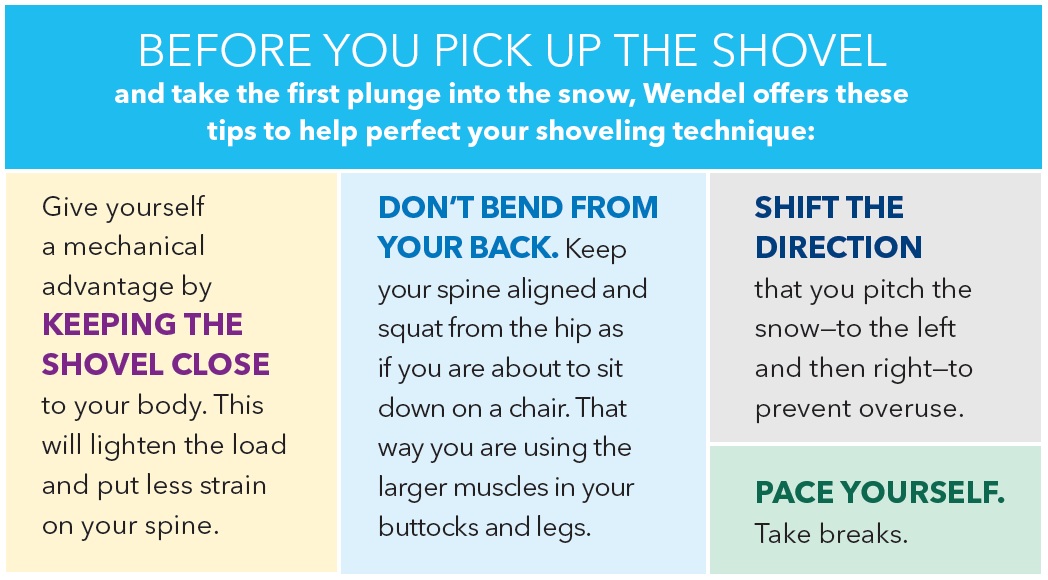Safety First When the First Snow Falls
The frigid predictions warn of a colder than average winter and more snow than last year. This white wonderland is an inevitable consequence of winter in the D.C. region—and so is the pain that can come from digging out.
“None of us is immune to back pain,” says Ann Wendel, PT, ATC, CMTPT, and clinic director at MedStar NRH in Lorton, Virginia. “In fact, worldwide 80 percent of all people will have at least one episode of back pain during their lives. It’s the most common cause of disability.”
It’s all comes down to body mechanics, she adds. “So many of us simply aren’t moving our bodies properly. We don’t breathe the right way when we exert ourselves or use our muscles to our advantage. So when we put extra strain on them—such as shoveling snow—we’re apt to injure ourselves.”
Building Strength and Stability
The best way to prevent weeks of discomfort following the first snowfall is by doing some prep work before you venture outside.
“Ideally you should be strengthening your core—your abdominals—all year round. A strong core helps create stability,” Wendel says. “Pilates, yoga and proper weight training are ideal exercises for a strong core. When you do these exercises, you learn to breathe correctly and exhale your breath upon exertion. That same breathing technique will help you tackle any physical chore,” she explains. “You will use your abdominals, glutes (buttock muscles) and chest muscles—which can carry the load far better than your back.”
Even if you exercise regularly, the winter months may have slowed your pace, she adds. “So before you go outside warm your muscles.”
Swing your legs like a pendulum while holding on to a chair, do simple squats, and rock back and forth on your heels to loosen your calf muscles.
All the Right Moves
Before your pick up the shovel and take the first plunge into the snow, Wendel offers these tips to help perfect your shoveling technique.
Snow shoveling tips:
- Give yourself a mechanical advantage by keeping the shovel close to your body. This will lighten the load and put less strain on your spine.
- Don’t bend from your back. Keep your spine aligned and squat from the hip as if you are about to sit down on a chair. That way you are using the larger muscles in your buttocks and legs.
- Shift the direction that you pitch the snow—to the left and then right—to prevent overuse.
- Pace yourself. Take breaks.

Injury?
What does Wendel advise if you do injure yourself despite your careful preparation? “When you get inside, don’t lie down. Keep moving to increase blood flow to your back. Then follow with ice to decrease the pain.
“You should see a doctor if the pain persists a week after the injury,” she says. “And ask your doctor for a referral for physical therapy. Therapy should be the first option for low back pain. It’s often not serious—and therapy to correct posture and body mechanics will be all you need for relief.”
But there are occasions when a cold compress isn’t enough, she warns. There are some red flags that mean you should stop what you are doing and go to your doctor, including:
- Sharp pain while shoveling
- Numbness and tingling down your leg
- Numbness in your groin
- Loss of bowel or bladder control
Wendel explains these symptoms could signal involvement of a nerve, and requires diagnosis and treatment.
Written by Emily Turk.
About MedStar National Rehabilitation Network
The MedStar National Rehabilitation Network is a regional system of rehabilitation care that offers inpatient, day treatment and outpatient services in Washington, D.C., Maryland, Northern Virginia and Delaware.
The Network’s interdisciplinary team of rehabilitation experts provides comprehensive services to help people recover as fully as possible following illness and injury. Rehabilitation medicine specialists, psychologists, physical and occupational therapists, and speech-language pathologists work hand-in-hand with other rehab professionals to design treatment plans tailored to each patient’s unique needs. Rehabilitation plans feature a team approach and include the use of state-of-the-art technology and advanced medical treatment based on the latest rehabilitation research.
The Network provides comprehensive programs specifically designed to aid in the rehabilitation of adults and children recovering from neurologic and orthopaedic conditions such as amputation, arthritis, back and neck pain, brain injury, cancer, cardiac conditions, concussion, fibromyalgia, foot and ankle disorders, hand and upper extremity problems, MS, Parkinson’s, post-polio syndrome, stroke, spinal cord injury and disease, and sports and work-related injuries.
Inpatient and day treatment programs are provided at MedStar National Rehabilitation Hospital located in Northwest Washington, D.C., and at more than 50 outpatient sites conveniently located throughout D.C., Baltimore, and all of Maryland, Northern Virginia, & Delaware. MedStar National Rehabilitation Network is fully accredited by The Joint Commission, the Commission on Accreditation of Rehabilitation Facilities (CARF), with CARF accredited specialty programs for Amputations, Brain Injury, Spinal Cord Injury and Stroke.
For more on MedStar National Rehabilitation Network and to find a location near you, log on to MedStarNRH.org









